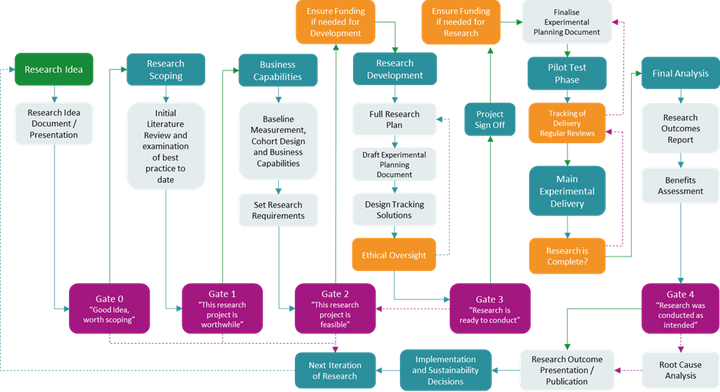Research Project Lifecycle
We realised that if we were going to add significantly to the evidence base of what works in preventing serious violence, and gain evidence for a public health approach, we needed to set ourselves up with a mechanism by which we could consistently deliver high quality research projects which were aimed at problems that existed in the public sector, with potential solutions or interventions that work for delivery in the public sector.
With this in mind, the Research Project Lifecycle was developed as an approach to merging project management productivity methods with best practice research and implementation techniques to ensure research is conducted in a manner that learns from what is already known, is delivered in a manner that can actually work in a live public sector environment, and that is rigorous enough to actually provide information about what works in prevention, with evaluation being thought about and planned from the beginning of the process. The lifecycle can be seen below:

Olphin, T.P.A. (2023). Research Project Lifecycle: A Structured Approach to Conducting Research in the Public Sector. Reading, UK: Thames Valley Violence Reduction Unit. @ Crown Copyright 2023
How the Research Project Lifecycle Works
A series of gateways (the pink or magenta boxes) create a structure of reviews that the project must pass. At each of these points, the project should be assessed against the statement in the box, to examine whether it should continue to the next stage, pause at this stage because it is worth continuing but we can’t yet, or whether it should be stopped at that gate and new ideas should be explored.
Gate 0 takes a project idea and assesses whether that idea fits into the aims of the organisations involved, and whether anything is known that would prevent it being possible at this early stage.
Gate 1 scrutinises the idea in terms of what is already known, allowing for us to learn from the best available evidence and identify where gaps exist in knowledge. It also allows us to identify the level of power and effect that is likely to be seen, so that we can design an appropriately powered study, to base our intervention on best evidence, and to identify what cohort characteristics might lead to the best possible outcomes. This stage may identify that evidence is already strong enough that no further testing is needed, and implementation should be done instead.
Gate 2 ensures that a cohort can be identified that is likely to benefit from the intervention that has been designed, and that there are sufficient cases in such a cohort. This can facilitate early knowledge of where multiple areas may need to collaborate to run an experiment. Baseline measurements are also taken to ensure that we know the likely rate of re-offending (or whichever bad outcome we are looking to prevent, in the target cohort). This stage also ensures that the right business capabilities are in place to be able to deliver and monitor the implementation of the project from the outset, and allows for appropriate funding and resourcing to be secured.
Gate 3 allows for full research design to be planned up front and pre-registered, carefully planning how the project and evaluation will be conducted, and ensuring ethical oversight is built into experimental design so that the most ethical way of researching the approach is used. The evaluation is pre-planned, so that it does not become a fishing expedition later. The project then moves into a pilot phase which is tracked, and then a full delivery phase, where all delivery and evaluation processes are examined and tracked to ensure it is running as intended.
Gate 4 ensures delivery of the final analysis, results and formal evaluation, conducted exactly as was planned during Gate 3, and allows for formal evaluation products to be drafted, adding to an evidence base of what works, how it delivered, and most importantly to what extent it worked.
Throughout the lifecycle there are feedback and re-design loops, providing opportunities to undertake further research and testing, and allowing us to learn continuously from all of the projects we undertake.
While it may seem complex, this process can be extremely swift to complete and helps to avoid many pitfalls that would otherwise lead to delays or project failure, and therefore it can actually speed up delivery of research projects significantly. It delivers swiftly, whilst ensuring that the project has been carefully designed, planned with the best available evidence in mind, and that evaluation is built in from the very start. This level of planning also makes it possible to design smaller experiments that can provide results much faster than would usually be possible, with some randomised trials being possible to design, run and evaluate within one financial year.
Our Director of Research and Data Science, Tori Olphin has presented on the research project lifecycle in depth, as well as how it can assist in small RCT design, for Youth Endowment Fund. The recording can be viewed here - YEF Research Lifecycle Presentation Recording, and the presentation can be accessed here - YEF Research Lifecycle Slides.
